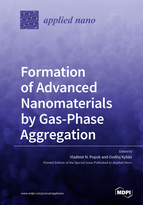Formation of Advanced Nanomaterials by Gas-Phase Aggregation
A special issue of Applied Nano (ISSN 2673-3501).
Deadline for manuscript submissions: closed (30 November 2020) | Viewed by 24820
Special Issue Editors
Interests: cluster beam synthesis; optical and electronic properties of nanostructures; ion-implanted polymers; III-N semiconductor materials
Interests: plasma deposition; gas-phase synthesis of nanoparticles; nanocomposites; functional coatings
Special Issues, Collections and Topics in MDPI journals
Special Issue Information
Dear Colleagues,
We intend to launch a Special Issue in Applied Nano on “Formation of Advanced Nanomaterials by Gas-Phase Aggregation”, which will be guest edited by Dr. Vladimir Popok and Dr. Ondřej Kylián. Relevant topics to be addressed are as follows:
- Synthesis and functionalization of nanoparticles using gas-aggregation methods;
- Novel approaches and techniques in cluster synthesis and deposition;
- Applications of nanomaterials prepared by gas-phase aggregation.
Considering your extensive expertise and previous publications, we would like to invite you to submit a regular paper or communication on the above topics for publication in this Special lssue. The deadline for the submission is 30 September 2020 with the aim of publishing the Special lssue in fall 2020. All submissions will undergo the peer-review system of Applied Nano, after which submissions will be considered for publication.
Applied Nano is a new interdisciplinary open Access journal of MDPI devoted to publish original works (reviews, regular research papers and communications) in any field of study involving the application of nanoscience and nanotechnology.
100% discount of Article Processing Charge will apply to the submissions accepted for publication in this Special Issue.
Prof. Dr. Vladimir N. Popok
Dr. Ondřej Kylián
Guest Editors
Manuscript Submission Information
Manuscripts should be submitted online at www.mdpi.com by registering and logging in to this website. Once you are registered, click here to go to the submission form. Manuscripts can be submitted until the deadline. All submissions that pass pre-check are peer-reviewed. Accepted papers will be published continuously in the journal (as soon as accepted) and will be listed together on the special issue website. Research articles, review articles as well as short communications are invited. For planned papers, a title and short abstract (about 100 words) can be sent to the Editorial Office for announcement on this website.
Submitted manuscripts should not have been published previously, nor be under consideration for publication elsewhere (except conference proceedings papers). All manuscripts are thoroughly refereed through a single-blind peer-review process. A guide for authors and other relevant information for submission of manuscripts is available on the Instructions for Authors page. Applied Nano is an international peer-reviewed open access quarterly journal published by MDPI.
Please visit the Instructions for Authors page before submitting a manuscript. The Article Processing Charge (APC) for publication in this open access journal is 1000 CHF (Swiss Francs). Submitted papers should be well formatted and use good English. Authors may use MDPI's English editing service prior to publication or during author revisions.
Keywords
- gas-phase synthesis and functionalization of nanoparticles
- cluster sources and related techniques
- applications of nanomaterials prepared by gas-aggregation





